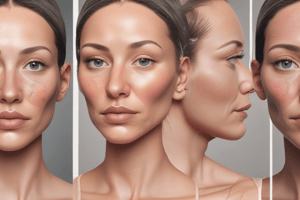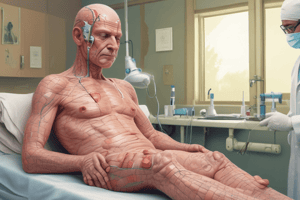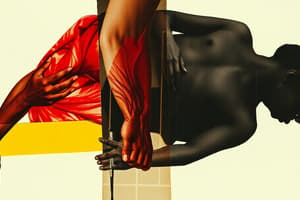Podcast
Questions and Answers
What is the primary purpose of splicing skin sheets?
What is the primary purpose of splicing skin sheets?
- To minimize scarring on the skin
- To enhance cosmetic surgery outcomes
- To reduce the size of the wound
- To cover larger wound areas (correct)
Which type of graft uses skin taken from the patient's own body?
Which type of graft uses skin taken from the patient's own body?
- Autografts (correct)
- Cryografts
- Allografts
- Xenografts
What technique involves aligning the edges of skin sheets without overlap?
What technique involves aligning the edges of skin sheets without overlap?
- Front Layer Technique
- Butt Joint Technique (correct)
- Z-Plasty Technique
- Overlap Technique
What is an important step in the preparation of skin sheets for splicing?
What is an important step in the preparation of skin sheets for splicing?
Which of the following is NOT a complication associated with splicing skin sheets?
Which of the following is NOT a complication associated with splicing skin sheets?
In which scenario would splicing skin sheets be most indicated?
In which scenario would splicing skin sheets be most indicated?
What technique is used to improve tension and aesthetics during skin splicing?
What technique is used to improve tension and aesthetics during skin splicing?
How should skin sheets be secured in place after splicing?
How should skin sheets be secured in place after splicing?
Splicing of skin sheet
Splicing of skin sheet
Flashcards are hidden until you start studying
Study Notes
Splicing of Skin Sheet
-
Definition:
- Process of joining two pieces of skin sheet (biological or synthetic) to create a larger graft for surgical procedures.
-
Purpose:
- To cover larger wound areas.
- To improve the texture and appearance of the skin.
- To enhance the integration of the graft with the surrounding tissue.
-
Types of Skin Sheets:
- Autografts: Skin taken from the patient's own body.
- Allografts: Skin taken from a donor of the same species.
- Xenografts: Skin taken from a different species (e.g., pig skin).
-
Techniques:
- Overlap Technique: Edges of skin sheets overlap and are stitched together.
- Butt Joint Technique: Edges are aligned and stitched without overlap.
- Z-Plasty Technique: Z-shaped incisions are made to reposition skin and improve tension and aesthetics.
-
Preparation:
- Clean and prepare the wound site.
- Trim the edges of the skin sheets to ensure a smooth joint.
- Ensure proper orientation of skin (dermis to dermis).
-
Stabilization:
- Use sutures, staples, or adhesive to secure skin sheets in place.
- Consider using a dressing or graft support to maintain position during healing.
-
Post-Operative Care:
- Monitor for signs of infection.
- Ensure the skin remains moist and protected.
- Follow up to assess healing and graft take.
-
Complications:
- Infection at the graft site.
- Poor graft take or necrosis.
- Scarring or textural differences at the junction site.
-
Indications:
- Burn treatment.
- Chronic wound management.
- Reconstruction after trauma or surgical removal.
-
Outcome Assessment:
- Evaluate healing rate, integration, and functional restoration.
- Assess aesthetic outcomes and patient satisfaction.
Definition and Purpose
- Splicing involves joining skin sheets to form a larger graft for surgical use.
- Aims to cover extensive wound areas, enhance skin texture, and improve graft integration with surrounding tissue.
Types of Skin Sheets
- Autografts: Skin sourced from the patient's own body provides the best compatibility.
- Allografts: Skin harvested from a donor of the same species, requiring careful matching to minimize rejection.
- Xenografts: Skin obtained from a different species, commonly pig skin, used temporarily due to rejection risks.
Techniques for Splicing
- Overlap Technique: Skin edges overlap and are secured with stitches for strength.
- Butt Joint Technique: Skin edges are aligned without overlapping, stitched carefully for a seamless join.
- Z-Plasty Technique: Involves z-shaped incisions to reposition skin, reducing tension and enhancing aesthetics.
Preparation Steps
- Clean the wound site meticulously to reduce infection risk.
- Trim skin edges for a smooth fit, ensuring proper orientation (dermis to dermis) for optimal healing.
Stabilization Methods
- Secure skin sheets using sutures, staples, or adhesives to maintain position.
- Dressings or graft supports may be applied during the healing process for additional stability.
Post-Operative Care
- Monitor for infection signs and ensure skin remains protected and moist.
- Regular follow-up to assess healing progress and graft acceptance.
Potential Complications
- Risk of infection at the graft site which can impede healing.
- Possible poor graft take leading to partial can also result in necrosis.
- Scarring or noticeable textural differences may occur at the stitch junction.
Indications for Use
- Effective treatment for burns, chronic wounds, and tissue reconstruction post-trauma or surgery.
Outcome Assessment
- Evaluate healing rates, integration quality, and restoration of function post-surgery.
- Assess aesthetic results and gauge patient satisfaction with the outcomes.
Studying That Suits You
Use AI to generate personalized quizzes and flashcards to suit your learning preferences.




